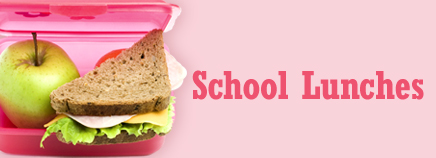
Buying lunch at school might be the first time kids get to call the shots on which foods they’ll eat. Luckily, school lunches have improved over the years, both in taste and nutrition, with many serving healthier dishes, such as grilled chicken sandwiches and salads.
But some still exceed recommendations for fat. In the typical school cafeteria, kids can still choose an unhealthy mix of foods, especially the less nutritious fare often available a la carte or in the vending machine. For instance, a kid might decide to buy a hot dog, day after day.
Lunchtime Opportunities
Use school lunches as a chance to steer your kids toward good choices. Especially with younger kids, explain how a nutritious lunch will give them energy to finish the rest of the schoolday and enjoy after-school activities.
Here are some other tips:
- Look over the cafeteria menu together. Ask what a typical lunch includes and which meals your kids particularly like. Recommend items that are healthier, but be willing to allow them to buy favorite lunch items once in a while, even if that includes a hot dog.
- Ask about foods like chips, soda, and ice cream. Find out if and when these foods are available at school.
- Encourage kids to take a packed lunch, at least occasionally. This can put you back in the driver’s seat and help ensure that kids get a nutritious midday meal.
Healthier Alternatives
Encourage kids to choose cafeteria meals that include fruits, vegetables, lean meats, and whole grains, such as whole wheat bread instead of white. Also, they should avoid fried foods when possible and choose low-fat milk or water as a drink.
If you’re helping pack a lunch, start by brainstorming foods and snacks that your kids would like to eat. In addition to old standbys, such as peanut butter and jelly, try pitas or wrap sandwiches stuffed with grilled chicken or veggies. Try soups and salads, and don’t forget last night’s leftovers as an easy lunchbox filler.
You also can perform a lunch makeover. These small changes do make a nutritional difference:
| Instead of: | Consider: |
| Higher-fat lunch meats | Lower-fat deli meats, such as turkey |
| White bread | Whole-grain breads (wheat, oat, multi-grain) |
| Mayonnaise | Light mayonnaise or mustard |
| Fried chips and snacks | Baked chips, air-popped popcorn, trail mix, veggies and dip |
| Fruit in syrup | Fruit in natural juices or fresh fruit |
| Cookies and snack cakes | Trail mix, yogurt, or homemade baked goods such as oatmeal cookies or fruit muffins |
| Fruit drinks and soda | Low-fat milk, water, or 100% fruit juice |
Nutritional Upgrades
Here’s how two lunches stack up after a typical lunch received a nutritional upgrade:
| Typical lunch | Nutritional upgrade | Why it’s better |
| Beef bologna on white | Lean turkey on whole wheat | Less fat and more fiber |
| Mayonnaise | Lettuce and mustard | Less fat and fewer calories |
| Potato chips | Carrots & celery with light dressing | Less fat and a serving of vegetables |
| Fruit cup in light syrup | Fresh grapes | Less sugar and fewer calories |
| Chocolate sandwich cookies | Homemade trail mix | Less fat and more fiber |
| Fruit punch drink | Skim milk | Fewer calories, less sugar, plus calcium |
| 980 calories | 725 calories | 255 fewer calories |
| 48 g fat | 13.5 g fat | 34.5 fewer grams of fat |
| 13.5 g saturated fat | 2.5 g saturated fat | 11 fewer grams of saturated fat |
| 125 g carbohydrates | 120 g carbohydrates | 5 fewer grams of carbohydrates |
| 59 g sugar | 52 g sugar | 7 fewer grams of sugar |
| 3 g fiber | 13 g fiber | 10 more grams of fiber |
Healthy Packed Lunches
Prepackaged lunches for kids are popular and convenient, but they’re also expensive and often less than nutritious. Instead, create your own packable lunch using healthier ingredients. Consider these components and pack them in plastic containers, resealable plastic bags, or colorful plastic wrap:
- cold-cut roll ups (lean, low-fat turkey, ham, or roast beef with low-fat cheese on whole wheat tortillas)
- cold pizza (shredded mozzarella cheese with pizza sauce on a flour tortilla, whole wheat pita, English muffin, or mini pizza shell)
- cracker sandwiches (whole-grain crackers filled with low-fat cream cheese or peanut butter and jelly)
- peanut butter and celery sticks
- veggie sticks with low-fat dip or dressing
- 100% fruit juice box or bottle of water
- optional dessert (choose one): flavored gelatin, low-fat pudding, oatmeal raisin cookie, graham crackers, fresh fruit
Be sure to check with the school to make sure that there aren’t any restrictions on what kids can pack in their lunches. And don’t forget to involve your kids in the process so that healthier lunches can become a goal they strive for, too.
Safe Packing
A packed lunch carries the added responsibility of keeping the food safe to eat. That means keeping hot foods hot and cold foods cold. One study found that fewer than a third of parents included a cold pack when packing yogurt, deli-meat sandwiches, and other foods that need refrigeration.
Here are some suggestions to keep lunch foods safe:
- Wash your hands first.
- Use a thermos for hot foods.
- Use cold packs or freeze some foods and drinks overnight. They’ll thaw in the lunchbox.
- Wash out lunch boxes every day or use brown paper bags that can be discarded or recycled.
- Toss in some moist towelettes to remind kids to wash their hands before eating and to clean up after.

